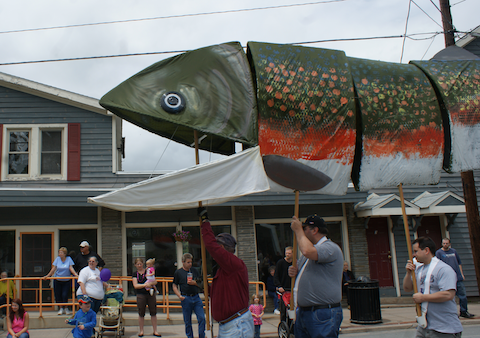
The Catskills region is renowned as the cradle of American dry fly-fishing. It’s the place where, in the 1800s, local anglers first began to alter English flies into shapes and patterns that mimic our own native insects.
Today, the fly-tier’s art thrives in the Catskills. Roscoe, known as “Trout Town, USA,” boasts several excellent fly-fishing shops and many local fishing guides. Phoenicia, where an important angling history collection was gutted by a 2011 fire at the local library, is now home to a digital trove of local fly-fishing lore, with a detailed hatch chart that tracks the dates of local hatches and the flies used to mimic them (catskillanglingcollection.org).
But in the Catskills, it’s not just fly-fishers who revere the trout. The native brook trout and stocked browns and rainbows that run through the cold, clear waters of the Catskills’ many creeks are part of the soul of the community — and when fishing season rolls around, everyone celebrates.
Every April at the start of fishing season, locals gather with pomp and circumstance for a ceremonial first cast at Junction Pool, at the confluence of the Willowemoc and the Beaverkill — a holy spot for fly-fishers. The start of the season is also fêted at the Rockland House’s annual Two-Headed Trout dinner, named in honor of a mythical Catskills trout fabled to haunt Junction Pool. Not to be outdone, nearby Livingston Manor, home of the Catskill Fly Fishing Center and Museum (catskillflyfishing.org), throws an annual trout party all its own. Each June, the little Sullivan County hamlet hosts the Trout Parade (troutparade.com), a funky, glittery Main Street affair that blends the joyous kitsch of Coney Island’s Mermaid Parade with old-fashioned small-town pep.
The world-class trout fishery of the Upper Esopus Creek and its feeder streams, flowing through the woods and valleys around Shandaken, was home to the nation’s first fishing resort: the Milo Barber boarding house on the Stony Clove creek, out of whose waters visitors would regularly haul hundreds of trout at a stretch.
In recent years, the Upper Esopus has yielded an inedible, but no less glittering, harvest: trout art. In 2010 and 2012, the local Ashokan-Pepacton chapter of Trout Unlimited partnered with local artists on the Leaping Trout Art Project (theleapingtrout.com), a series of aluminum cut-outs of a trout in mid-leap that were transformed with paint, fabric, glass and wood into dozens of unique artworks.
The trout were put on display at shops, diners and galleries along the Route 28 corridor from Arkville to Boiceville, forming an art trail that visitors could follow, and then auctioned off to raise money for Trout Unlimited’s conservation and outreach programs. Today, visitors can see all of the artworks on the project’s website, or visit a couple that still hang in the Phoenicia Diner (phoeniciadiner.com).
This article originally appeared in the print version of the 2014 Catskills Outdoor Guide, our annual publication covering recreation in the Catskills great outdoors. The Catskills Outdoor Guide is distributed across the Catskills region and at select locations in the NYC metropolitan area. Find a copy near you here.















